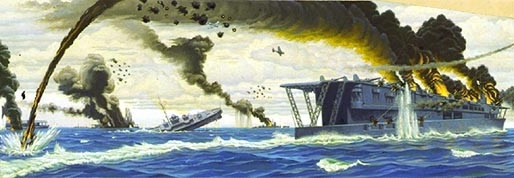
Griffith Baily Coale
Griffith Baily Coale was born in Baltimore, Maryland, the eldest son of a prominent family that encouraged his interest in art. Eventually he studied at the Maryland Institute of Art where he served as president of the Art Student's League for two years. He later studied mural painting in Europe for three years. Returning to Baltimore, he worked as a professional painter for seven years, and when World War I broke out, Coale worked as Marine Camoufleur for the U.S. Shipping Board from 1917 to 1918.
In 1922, Coale moved to New York where he painted portraits, decorative paintings for buildings, and murals. He executed murals in a number of prominent buildings, including the Metropolitan Life Insurance Company Building, the Criminal Courts Building, the City Bank Farmers Trust Building. His work was not confined to New York City, but is seen throughout the East.
In 1941, sensing that war was imminent, Coale approached Admiral Chester W. Nimitz with the idea of having combat artists on board navy ships to observe operations and document what they saw in paintings. From his experience in World War I and knowing that the British Navy had a successful war art program, Coale wanted to convince the U.S. Navy of the value of art in documenting war. Artworks could go beyond the photographic image and written document in providing a different perspective of the experience of war. Admiral Nimitz agreed to the plan and established the Navy Combat Art program.
On August 8, 1941, Coale received a commission as a Lieutenant Commander in the Naval Reserve working as a Combat Artist for the Office of Public Affairs. His first assignment put him on a patrol in the North Atlantic, where he witnessed the sinking of the U.S.S. Reuben James. He described and illustrated this experience in a book entitled North Atlantic Patrol. His next assignment took him to the Pacific, where after observing the wreckage from the attack on Pearl Harbor and hearing eyewitness accounts, he rendered illustrations of that disaster. He also observed troops training for the invasion of Midway and traveled to that island shortly after its recapture. This led to the publication of another book, Victory at Midway. Navy Public Affairs next sent him to the Southeast Asia Command and Ceylon, and for his final assignment at the end of the war he painted two murals (now lost) for the Naval Academy, depicting the attack on Pearl Harbor and the Battle of Midway.
Coale left the Navy in 1947 with the rank of commander and returned to his home in New York, where he died in 1950.


